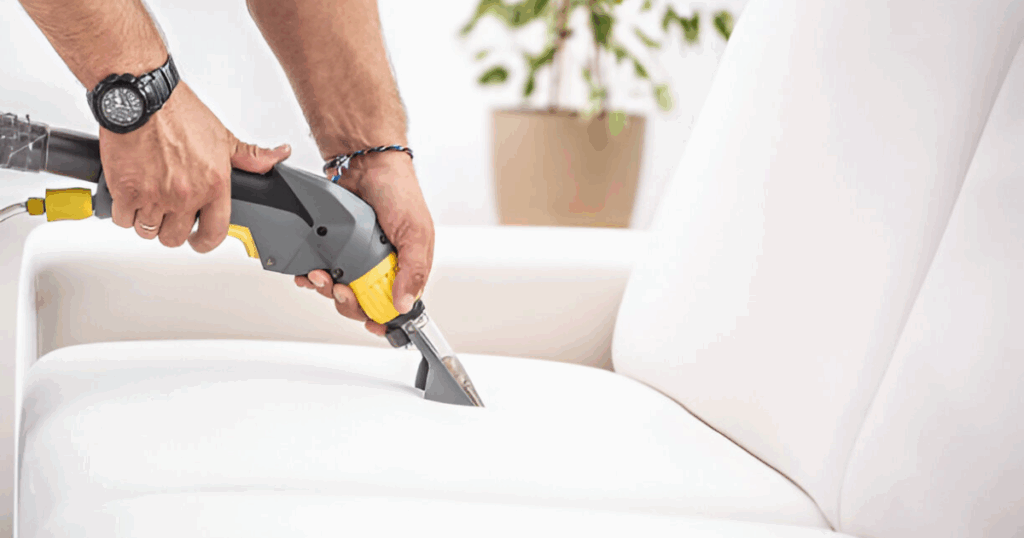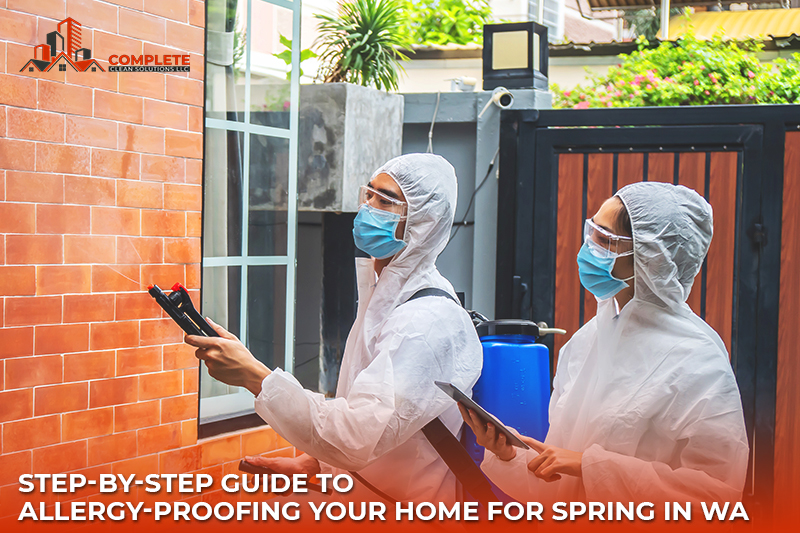Spring in WA is pretty but rough. You’ve got sunshine, fresh blooms, and sneezes that never end. Most folks think pollen only hits you outside. That’s not true. It sneaks inside fast. So let’s fix that with real tips that work.
If you are sick of itchy eyes and runny noses, you’re not alone. WA spring allergies hit hard because we’ve got trees like alder, birch, and cedar all going wild. Then you’ve got mold and dust living inside with you. That combo can crush your immune system. So the goals here are simple: allergy-proof your home room by room and keep those triggers out.
Start with a Deep Clean That Means Business

You can’t skip spring cleaning. But this isn’t your usual wipe-and-go. This is deep, detailed cleaning with allergy control in mind. You are not just making things look good. You are fighting off pollen, dust, and mold that fuel your allergy storm.
- Vacuum every inch of carpet with a HEPA filter vacuum
- Wash all bedding, blankets, and throws in hot water weekly
- Dust surfaces with a damp cloth so it traps allergens instead of spreading them
- Don’t forget ceiling fans, light fixtures, and air vents. Those things hide dust
- Scrub down baseboards and corners that collect grime
If that sounds like a lot, it is. And if you don’t want to do all that heavy lifting, book a pro team that gets it.
Lock Down the Airflow
Allergens ride the air like it is Uber. If your home isn’t sealed up or filtered right, they move fast. The first thing to check is your HVAC system. If your air filter is cheap or old, you’re basically blowing pollen and dust into every room.
- Use high-efficiency filters (look for MERV 11 or higher)
- Change them every 30 to 60 days in spring
- Clean air vents and ducts at least once a year
- Get your HVAC checked before the season kicks in
Also, don’t open windows during peak pollen hours. That’s usually early morning or late afternoon. Keep windows shut, especially on dry, windy days. Use a HEPA air purifier in bedrooms and living spaces for extra allergy control.
Attack the Bedroom First
You spend 7 to 9 hours in your bedroom. That’s where allergens mess you up the most. If you wake up stuffed up or with puffy eyes, this is your battleground.
- Get dust mite-proof covers for pillows and mattresses
- Ditch old pillows or wash them hot every month
- Keep pets off the bed, no matter how cute they are
- Wash sheets and cases once a week in hot water
- Remove wall-to-wall carpet if you can. It traps everything
Also, skip heavy curtains. They hold pollen and dust like a sponge. Use blinds or washable shades instead. Keep the windows shut and let the air purifier run while you sleep.
Crush Mold in the Bathroom
Bathrooms are a mold’s playground. Moisture plus bad airflow equals mold spores in the air and on the walls. You breathe those in every day without knowing it. That’s why this part of your house needs serious allergy-proofing.
- Run the exhaust fan during and after every shower
- Wipe down tiles, tubs, and sinks daily if possible
- Use mold-killing cleaners like vinegar or hydrogen peroxide
- Check under sinks and behind toilets for leaks or damp spots
Also, wash your bath mats weekly and skip the fabric ones if you can. If your shower curtain smells musty, replace it. That smell? It’s mold living in the fibers.
Keep the Kitchen from Going Toxic
The kitchen can be a hotspot for mold, dust, and pests. Those three love to trigger allergies. And you probably don’t notice the slow buildup until it gets bad.
- Clean your fridge drip pan. It collects mold and bacteria
- Keep dry food sealed tight to avoid bugs and dust
- Check under the sink and behind appliances for leaks or crumbs
- Take out the trash daily and keep bins washed and dry
Also, avoid using air fresheners or scented cleaners. Those mess with sensitive noses. Stick with fragrance-free or natural cleaners so your sinuses don’t freak out every time you wipe a counter.
Handle Your Pets Like a Professional
We love our pets, but they are allergy factories. Pet dander floats through the air and sticks to furniture, clothes, and even walls. If your allergies flare up but you don’t want to give up your fur buddy, it’s time to level up your strategy.
- Brush pets outside, not in the house
- Bathe them weekly if they’re cool with it
- Keep them off furniture and out of bedrooms
- Wash pet beds weekly in hot water
- Vacuum with a HEPA filter every few days
You can’t totally eliminate dander, but you can keep it from building up. And always wash your hands after petting them or cleaning up. Even that helps a lot more than people think.
Fix Up the Entry Points
Every time someone walks in, they bring the outside world with them. Shoes, jackets, and bags. They all carry pollen, dust, and more. If you don’t control the entry, allergens spread fast through the house.
- Leave your shoes at the door and switch to indoor-only ones
- Wipe down pets before they come inside
- Keep a doormat inside and out for double barrier control
- Use washable rugs and clean them often
If you’ve got a mudroom or entry space, make that your allergy shield zone. It’s the first line of defense, and it makes a big difference in what reaches the rest of your house.
Don’t Let Clutter Win
Allergy-proofing your home doesn’t mean just cleaning. It means simplifying your space. The more stuff you have, the more dust and allergens build up. And the harder it is to clean fast.
- Clear out stuff you don’t need or use
- Keep surfaces open and easy to wipe down
- Use storage bins with lids instead of open baskets
- Store seasonal clothes or linens in airtight containers
Less clutter means less dust. Less dust means fewer allergies. And it also just feels better to walk into a clean, open space that doesn’t make your nose itch.
Spring-Proof Your Yard
You may not live outside, but your yard affects your allergies, too. Pollen doesn’t care about walls. It blows through doors, windows, and vents like it owns the place.
- Mow the lawn weekly and water it often to trap pollen
- Trim trees and bushes near windows and doors
- Remove dead leaves, weeds, or standing water
- Don’t hang laundry outside during peak pollen days
Also, shower and change clothes after yard work. Pollen sticks to hair and fabric. You don’t want to drag that inside and sleep in it. That’s how indoor allergies sneak up on you.
Upgrade Your Tools
The right tools make allergy-proofing easier and faster. You don’t need to buy fancy gadgets. Just pick things that do their job well and last through spring.
- Use a HEPA vacuum that traps tiny particles
- Get a microfiber mop that doesn’t just spread dust
- Buy fragrance-free detergents and cleaners
- Run a good air purifier in key rooms
Also, don’t cheap out on air filters or allergy covers. They might cost more up front, but they save you from doctor visits and meds in the long run.
When to Call in the Professionals
Sometimes you just can’t do it all. That’s real life. Between work, kids, and the chaos of spring, deep cleaning and allergy-proofing take time and hustle. That’s when pro cleaners make sense. They don’t just clean. They know how to allergy-proof your home and do it right the first time.
In WA, our cleaning crew gets it done. They offer full services that target pollen, dust, mold, and everything else wrecking your sinuses. If your spring is more sneezing than sunshine, give them a call. You won’t regret handing off the dirty work.
Final Thoughts
Spring allergies in WA don’t have to wreck your life. You can beat them. But it takes a full-on mindset shift. You’ve got to think prevention, not just treatment. Allergy-proofing isn’t a one-time chore. It’s a habit. A new way of keeping your home safe and clean all season long.
Follow these steps. Use the right tools. Cut the clutter. Clean smarter. And when in doubt, let a professional team step in and crush it for you. You deserve to breathe easy in your own home.

